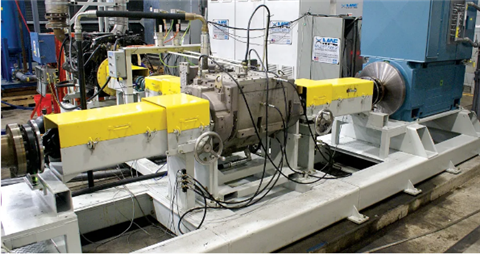MAE supplies transmission dyno to army
08 November 2022
Mustang Advanced Engineering (MAE) announced that the company has completed the installation of a diesel engine driven, electric motor loaded Hydro Mechanical Power Train (HMPT) transmission dynamometer test stand at the Red River Army Depot (RRAD) in Texarkana, Texas.
 Mustang Advanced Engineering (MAE) recently completed the installation of a Hydro Mechanical Power Train (HMPT) transmission dynamometer test stand at the Red River Army Depot. (Photo: MAE)
Mustang Advanced Engineering (MAE) recently completed the installation of a Hydro Mechanical Power Train (HMPT) transmission dynamometer test stand at the Red River Army Depot. (Photo: MAE)
The project included turnkey installation, commissioning, testing and training for the test stand and self-contained closed-loop liquid cooling system capable of testing the HMPT-500-3ECB and HMPT-800 cross-drive transmissions.
This project also included the construction of an attached steel awning with concrete pad to house the fuel storage tank for the diesel engine, the external heat radiating unit for the self-contained liquid cooling system, the dynamometer load units, engine fuel supply system, control and data acquisition systems, self-contained cooling systems for the engine, transmission and fuel and load units.
The test stand provides testing of military cross drive type transmissions such as the Bradley Fighting Vehicle System (BFVS) transmission and Multiple Launch Rocket System (MLRS) transmission in accordance with the National Maintenance Work Requirements (NMWR). The test stand provides input power to the test article using a 675 hp Cummins VTA-903 diesel engine with independent electric motors loading the output drives of the test article, closely simulating in-vehicle real world operating conditions.
“This installation is another success for MAE and significantly enhances Red River’s rebuilding/testing capabilities,” said David Ganzhorn, VP Sales at MAE. “The project showcases MAE’s experience, quality and innovation.”
STAY CONNECTED




Receive the information you need when you need it through our world-leading magazines, newsletters and daily briefings.
POWER SOURCING GUIDE
The trusted reference and buyer’s guide for 83 years
The original “desktop search engine,” guiding nearly 10,000 users in more than 90 countries it is the primary reference for specifications and details on all the components that go into engine systems.
Visit Now
CONNECT WITH THE TEAM









